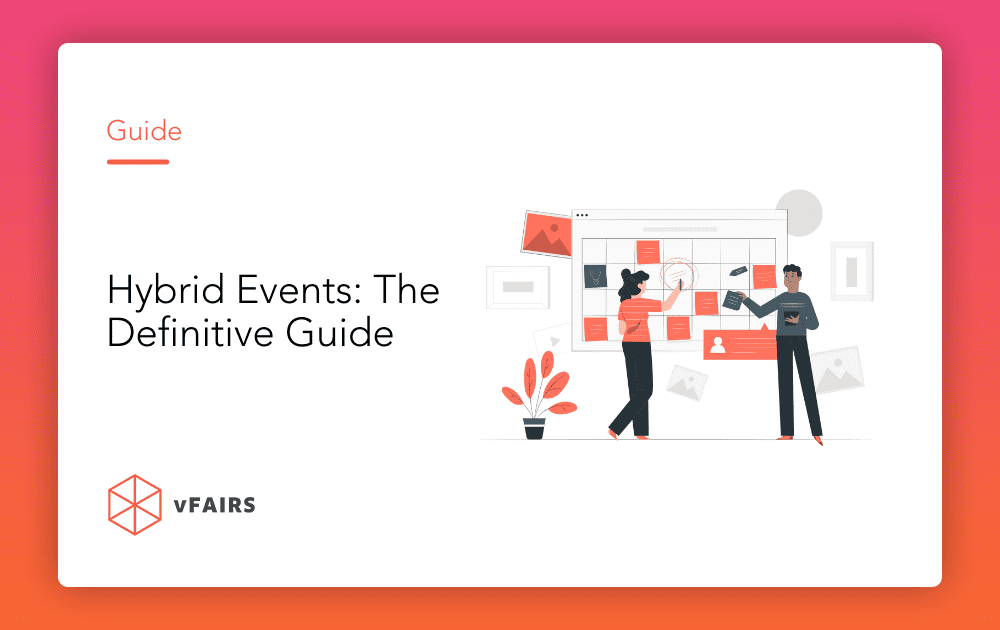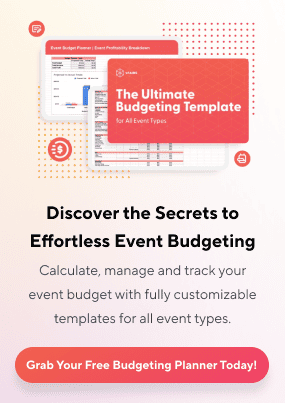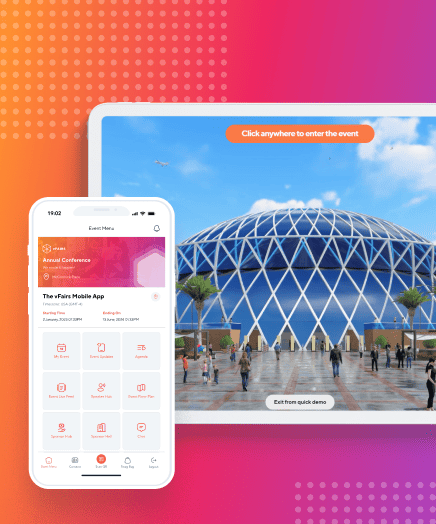As we embrace a new era of connectivity and adaptability, hybrid events have emerged as a pivotal concept, bridging the gap between in-person and virtual experiences. In this comprehensive guide, we will delve into the exciting realm of hybrid events, exploring how they seamlessly blend the best of both worlds to create immersive, engaging, and inclusive experiences.
Whether you’re a seasoned event professional looking to adapt to the ever-changing industry or a newcomer seeking innovative ways to connect with your audience, our guide is your roadmap to unlocking the full potential of hybrid events.
Video: How To Run Hybrid Event
Read through this comprehensive guide to hybrid events and learn how to ace them with the right strategies.
Chapter 1: Hybrid Events Fundamentals
Hybrid events are the best of both worlds and in the current climate, most companies can prefer them or an exclusively virtual or in-person event. Let’s start with the very basics of what hybrid events are, how they work, and what you can achieve with them.
What are Hybrid Events?
Hybrid events are seminars, trade shows, career fairs, conferences or any other gathering that uses a combination of aspects from in-person and virtual events. They are fully prearranged events that allow the attendees, remote or on-site, to interact and engage with one another.
Hybrid events are one event, but it can provide two experiences for two distinct audiences.
The concept of hybrid events is not a new one. A classic example of hybrid events would be the televised sports events, concerts, and award shows. Hybrid events help people with similar interests and common goals to network, learn, and share information with each other.
Therefore, there is no one-size-fits-all approach for hybrid events; event organizers have complete control of the event planning and execution.
First Ask Yourself, “Why Do You Need To Host Hybrid Events?”
The most important question in event planning is whether to integrate a virtual element in your events or not. Is it appropriate for your event? When does it make sense to opt for a hybrid event over a purely onsite or completely virtual one?
The Hybrid Event Arena
Hybrid events shine in scenarios where you can seamlessly blend onsite and virtual experiences. Here are some prime candidates for hybrid execution:
- Industry trade shows
- Professional conferences
- Corporate sales kick-off meetings
- Worldwide town hall meetings
Hybrid events come to the rescue when physical attendance isn’t feasible for all. Consider these situations where a hybrid approach is ideal:
- Participants who are unable or unwilling to travel.
- Organizations facing travel budget constraints.
- Event locations with limited space or accessibility, preventing full onsite attendance.
A smart move is to conduct a pre-event survey. This helps gauge your potential attendees’ preferences and constraints. If there’s a significant tilt towards virtual attendance, steering towards a hybrid event could be your winning strategy.
Hybrid Events Goals
Hybrid events might not be the easiest of events to host, but once you are familiar with its benefits, you are going to put some effort into hosting your next hybrid event.
While the list expands further, here are a few benefits of hybrid events worth considering:
- Hybrid events give a lot more space for in-person connection. It allows the participants to experience the human connection.
- Hybrid events allow people to experience the event virtually if they cannot attend an in-person conference due to logistical or other reasons. .
- Hybrid events limit entry barriers by allowing participants to interact with your brand and content regardless of geo-location.
- Hybrid events help with reducing carbon footprint. With a limited number of attendees in-person, your event will contribute to lesser thrown meals, transportation, and rental chairs.
Hybrid Events vs. In-Person Events
The main difference between in-person and hybrid events is that live or in-person events are hosted in a venue where all the attendees are physically present. Hybrid events, however, are a perfect blend of in-person and virtual events.
At the in-person events, attendees can communicate and network face-to-face. With all the attendees being present at the venue, they can view and examine products and services offered by the exhibitors.
Additionally, this gives them an opportunity to provide immediate feedback at the event. In-person or live events provide attendees with a chance to develop relationships with the industry professionals and participate in live seminars and break sessions.
Hybrid events, on the other hand, offer better flexibility to their attendees by giving them the opportunity to attend the event physically or virtually. With some aspects of the event being virtual, companies can also request top-tier speakers to present remotely. Not to forget, hybrid events let attendees network with others from around the world, not just those present at the physical venue.
Hybrid Events vs. Virtual Events
Virtual events or online events take place completely online. Virtual events can be a blend of live streamed or prerecorded content for the online audiences. Some common examples of virtual events would be webinars, web conferences, webcasts, product displays, and online meetings.
Virtual events provide companies with the chance to engage with the global audience and target thousands of people all around the world. With greater accessibility, the attendees can easily hop online from the comfort of their home making it much easier to attend the event.
Virtual events also allow enterprises to capture and gain engagement data, automatically with analytics through click details, watch times, and poll responses.
If virtual and in-person events were on a spectrum, hybrid events would place exactly in the middle. Hybrid events offer flexibility and convenience which allow the organizers to expand the impact of the event anywhere in the world.
Hybrid events come with great benefits and, consequently, are a great method for cost reduction for the organizers and attendees alike.
Chapter 2: Pros and Cons of Hybrid Events
Here are the five top pros if you are planning to host a hybrid event soon.
Pros
1. Increased Attendance Capability
According to many experts, the most obvious pro is increased attendance. When you make your event accessible online, it enables those people to “attend” your event who might otherwise be unable to attend. Some common reasons include travel, cost, time, as well as venue size constraints.
Also, in a number of cases, up to 50% of virtual attendees have never ever attended the physical version of the conference or meeting. Hosting an online portion as a part of a hybrid event helps you target dormant employees, members, along with customers of your organization.
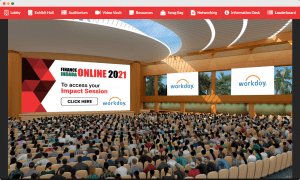
2. Eco-friendly
Reducing the need for travel means a reduced environmental impact. If you plan to include a virtual environment, some of the biggest additional advantages, such as eco-friendly events, can be enjoyed. These advantages have previously never been possible.
First and foremost, you will be interacting with zero-waste in a virtual environment. Additionally, your virtual portion produces only 1% of the carbon emissions that in-person events produce. Essentially there is nothing to build and nothing is thrown away. Hosting a hybrid event is a much cleaner and more eco-friendly alternative to a fully in-person event.
3. Powerful Sponsor Opportunities
Nearly around 72% of corporate sponsors are heavily interested in participating in a hybrid event. This is the best possibility as long as they can effectively reach both audiences (in-person and virtual).
Hybrid events are of incredible value for sponsors. The top reason is the increased reach. In simple words, more attendees at your event automatically mean a larger lead pool for sponsors. This is the number one reason for better sponsorship.
The second reason is that the sponsors can easily communicate 1:1 with interested parties. This is done while they are also interacting with online virtual attendees. Some demographics, particularly Millennials, highly prefer virtual communication. The resultant possibility is that this may lead to increased participation at their virtual booth.
Another reason is the increased opportunities for sponsorship. They can sponsor live streams, event apps, and more, instead of just sponsoring live collateral.
Also, this offers more flexibility in your sponsorship prospectus. You can simply have live sponsors, virtual sponsors, or even both.
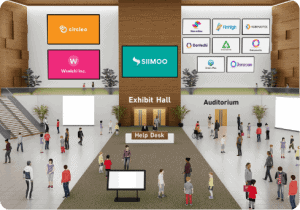
4. Higher Audience Engagement
When it comes to higher audience engagement, adding a virtual element to your live event is the key. This opens up a wider variety of engagement opportunities as compared to a strictly live event (both during and post-event).
This is due to the fact that your virtual audience is actively participating from their mobile devices or desktop computer. It means they can talk, share, like, comment, and perform many more online functions.
For example, you can plan to host polls during sessions. They can include both the live as well as your online audience.
On the other hand, you could have a Q&A session with a speaker at the live event. The online audience can submit questions as the presentation is being live-streamed, and have their questions answered at the same time as the live audience. They just need a moderator or a screen in place for the presenter to see questions online. Later you can invite them to have a Q&A with your online audience. This can commonly be done at a studio that broadcasts your live event online.
Not only this but you can even help live as well as virtual attendees network with each other. Attendees can search user-profiles and find prospects for in-person or virtual meetings.
The easiest way to keep track of all these engagement avenues is to start with your attendees. Whether online or offline, what will their entire journey look like? When you plan your event audience-first, you ensure that you weave in the necessary and the most sensible engagement opportunities for them.

5. Valuable Data
Another biggest benefit of hybrid events comes from the data along with the insights it shows. For example, at a live event, you can simply perform a headcount and quickly estimate how many viewers participated in your session.
But in the case of hybrid events, you know the exact participation numbers. You also know how they engaged and when they dropped out of your session. Not only this but you also gain information about your attendees’ interests with the help of matchmaking data and session participation.
All this valuable information helps you improve your future content. In the case of sponsors, well, they gain essential info on booth traffic as well as attendee engagement. This greatly helps them prove a positive return on investment.
Now due to the online nature of hybrid events, you are able to gain a lot of trackable metrics. These metrics are those that you simply can’t measure offline. A hybrid event platform is the most essential component for providing these sorts of insights.
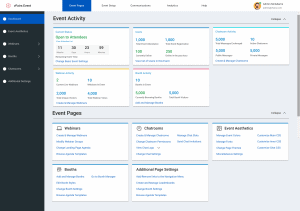
Cons
On the other hand, the five most common cons of hosting a hybrid event include:
1. Delivery Has Potential to Become Complex
Trying to host a fully built-out in-person and virtual event simultaneously could become complex. When you plan to deliver a hybrid event, people generally believe they must deliver two almost-identical events simultaneously virtually and in person.
However, hybrid events come in may different forms. It could simply be a live stream with a few other engagement features, or offering exhibitors the chance to have a booth on the live trade show floor and the virtual floor. It doesn’t require a whole lot extra. Additionally, you could host a live event then the online portion after the live event has closed.
Thinking strategically when it comes to planning will help you understand just how large your event plan needs to get, but there are lots of ways to mitigate extra work that might not foster results.
2. Sponsors May Need Extra Guidance
Most of the time, it is harder to get sponsors on board if you are unable to convince them that they are getting sufficient exposure. This becomes one of the biggest challenges for the host if not tackled in the right manner.
Getting more sponsors onboard exclusively depends on the value your event providers can provide to them. The technology needs to ensure that the sponsors receive similar benefits as opposed to a physical event. The key is to educate your sponsors about past event successes, attendee behaviors and the increased level of exposure they will get at your hybrid event.
3. Additional Coordination & Engagement Requirements
If you are a single person organizing as well as managing a hybrid event, you may experience some challenges planning and executing your event. Other than the time, effort, and resources you will need to set up either a live or online event, directing cross-channel hybrid events add a new dimension completely.
You will be considering the customer experience for both types of attendees. You need to decide how you can provide them a wholesome experience. Also, the technical and physical aspects of an event can be challenging and intricate. Especially, when it comes to conducting the event properly and running it smoothly.
As a one-man-army, another challenging part is to manage virtual experiences for the participants who join the event from a variety of locations across the globe. So, it is important to focus on the demands of both attendees.
With the help of an expert team and a professional virtual event platform, things can be easily managed. The online platform will provide solutions for live-streaming equipment. It will also enable practical discussions for online and offline engagement.
4. Potential Connectivity Issues
When conducting hybrid events, another concern that can arise is the uncertain connection issues. Due to connectivity issues, virtual participants are not able to get the complete experience. As a result, you face demotivation of the attendees connecting online, as it disrupts their experience considerably.
Naturally, what can be more frustrating than having connection lags while being part of a hybrid event virtually? This issue will make them avoid joining in the session.
According to 67% of event organizers, for a smooth experience, it is important to ensure smooth technology otherwise you will face the biggest challenge.
The solution is simple. You need to research and opt for an online platform that offers smooth connectivity throughout the event. The team responsible for technical issues needs to be experts in their field.
5. Change Is Always Challenging
Hybrid events challenge people to change by their very nature. Whilst the hybrid events pros and cons do not shout change, they certainly cause. This happens because of the opportunities that are provided by such events. Attendees have better choices and organizations are free to decide whether or not to hold hybrid events.
Well, you can argue that change is a good thing but not everyone wants or accepts the change.
In-person events were the only option up until about 10 years ago. People are used to them. They know what to expect and how business is generated. In short, they are comfortable and argue upon the so-called fact that when something is not broken, why fix it?
Thanks to COVID-19 that changed everything and events went significantly virtual. We know virtual works well. And when you add virtual to an in-person event, you are making big changes once again.
Not everyone accepts change or is ready for it. The best solution is to educate yourself first, educate your audience and partners, and work with a team that can support your specific event goals, regardless of the event format.
Chapter 3: What Do Hybrid Events Look Like?
Hybrid events can take many forms and serve many different organizational goals. Let’s dive into a few of the most popular hybrid event formats.
Hybrid Event Examples
1. Conferences
Hybrid conferences are the perfect blend of physical and virtual conferences. Hybrid conferences are both where physical and virtual attendees can network, watch speakers share valuable information and enjoy panel discussions live and online.
Online attendees may only have access to a few live speaker sessions and panels with access to online breakout rooms for networking.
Planning hybrid conferences require some tools to help you get it all done. For hybrid conferences, the most essential tool is to have virtual event software that allows you to share the conference online and livestream the complete conference.
Management software is another tool that is much needed for a hybrid event. A combination of both virtual event and management software would be a great option for hybrid conferences.
2. Career Fairs
A hybrid career fair can be the perfect approach to combining virtual and in-person hiring fairs. In a hybrid career fair, you can bring together recruiters and the local job seekers in a physical venue for a more intensive in-person communication.
It also offers virtual exhibit booths where remote candidates can view vacancies and apply for the available positions. With companies offering more remote job positions, hybrid job or career fairs can be a great opportunity for employers and candidates alike.
Educational institutes can host a hybrid career fair by partnering with the team of hiring managers and recruiters to find the right candidates at both physical and virtual settings. Employers are provided with all the relevant tools to gain meaningful analytics with candidate engagement and satisfaction.
Therefore, hybrid events are a win-win situation for both the parties.
3. Trade Shows
Hybrid trade shows are the new way forward after the pandemic. They can accommodate both, those who can travel and those who would like to attend but are unable due to scheduling, budget or a number of other concerns.
A hybrid trade show needs to predominantly showcase products & services, allow attendees to submit orders, and company reps to garner leads both in-person and virtually. Product listings, order sheets and live chats can be a great way to help sellers interact with attendees and generate new business.
4. Hybrid Presentations
A presentation that integrates physical and virtual events together seamlessly is known to be a hybrid presentation. Hybrid presentations engage both their audiences where they can listen to speakers, network with both online and offline attendees, and participate in multiple activities.
Having access to a digital audience online, speakers or hosts can share information in-person to local attendees and virtually to the global one.
With hybrid presentations, people attending virtually can always have engaging discussions for each session, participate in live polls, exchange business cards digitally and more.
If attendees are unable to travel for some reason, they always have the option to attend it virtually.
5. Exhibitions
Hybrid exhibitions, it’s more about the creation of improved value.
Hybrid exhibitions can be a great opportunity for organizations like museums and art galleries to educate a worldwide audience. They can host their exhibits at a physical venue and let people around the world access it through virtual media.
Hybrid exhibitions can be great for nonprofit organizations and schools where they can showcase their work, and celebratory events. vFairs offers a poster hall for hybrid exhibitions where hosts can display research, projects, artwork, and more for attendees.
Hybrid exhibitions can be tricky to host, however. Exhibitors always want displays that can be easily accomplished. Displays should be easily assembled, have their own aesthetic, weigh almost nothing, and must have the ability to reconfigure in two more shapes and sizes.
Things have changed very much for the exhibitors as well. With hybrid events becoming the future, exhibitors now must merge the virtual and the physical world.
Hybrid exhibitions can provide the perfect combination of flexibility, portability, innovative design, and an event with two experiences.
Hybrid Event Case Study
Bernard Health has always been focused on solving health care benefits and HR challenges faced by individuals and employers alike. Bernieportal, is an all-in-one HRIS platform for small and midsize employers. It serves the purpose of managing people and building businesses that are easy and effortless.
Bernie portal hosted their 4th annual conference, Weekdays with Bernie, that brought together HR industry leaders and innovative thinkers for networking, strategic solutions and learning opportunities.
The conference was hosted locally in Nashville, Tennessee and online for remote attendees.
The Challenge:
Ensuring the hybrid event experience was similar for both the in-person and virtual audiences.
What Was the Hybrid Conference Like?
The Bernieportal hybrid conference hosted breakout sessions for people attending in-person which was easier for them to set up logistically. For online attendees, sessions were livestreamed for which they used YouTube to directly embed the link to the events platform.
Attendees stayed within the platform and were easily directed to the conference.
Sponsors, already being acquainted with the virtual experience, responded constructively to the hybrid model. Although the onsite crowd was smaller, they did receive a good sponsorship turn out. Their booths were set onsite and online both and received good amounts of leads from their network sessions.
There was certainly a boost in the engagement seen at the hybrid conference. Attendees who were present onsite were thrilled to be there in-person. Online attendees were actively interacting with the CEO and other participants on the ground. Speakers made sure to address the questions of the remote attendees which spiked the engagement.
Following were the features of Bernieportal hybrid conference:
- Virtual auditorium for speaker sessions
- Leaderboard to track points gained by the attendees
- Networking lounge
- 3D animated lobby
- Exhibit hall with an aerial view where booths were clearly displayed
Results
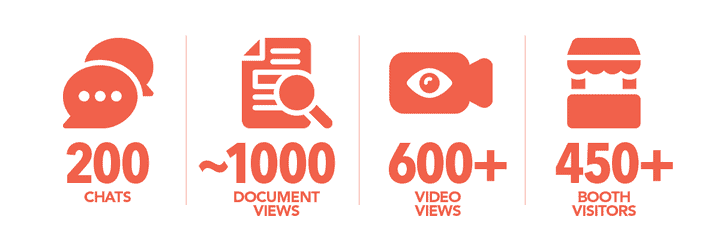
Bernieportal considered their hybrid conference an absolute success. With over 200 chats, 450+ booth visitors, almost 1000 document views and 600+ video views, the hybrid conference exceeded expectations.
Their favorite feature was the live streaming of the conference via YouTube.
Chapter 4: Hybrid Event Platform
A hybrid events platform offers the opportunity to seamlessly blend the advantages of in-person and online event hosting for a truly exceptional experience. The primary objective of this platform is to unite both the on-site and virtual audience, granting them an equitable chance to engage with each other as if they were physically present in the same location.
Have a look at the 10 best hybrid event platforms in 2024.
Key Features
1. Super Simple Event Setup
Hybrid events should have a unique, yet simple event setup. Planning such events can be overwhelming since you have to cater to two distinct audiences. Therefore, for a physical venue, booths, product displays and a room for speaker sessions are set up.
For the virtual audience, a virtual event platform should take care of everything. Virtual event platforms offer multiple features including live streaming, polls, Q&A sessions, and networking chat rooms.
2. Integrated Experience
Hybrid events are the best of both worlds. For onsite attendees, you need to make a special effort to treat them as an absolute self-selecting group. Networking opportunities and interactive learning activities are essential.
On-site and online attendees have easier access to different types of content. Virtual attendees usually have access to takeaway resources such as white papers, and brochures. However, on-site attendees definitely have the advantage of being physically present and therefore, networking comes easy to them.
Live attendees can easily check-in online to see the activities going on. They have easy access to content hosted on the virtual platform.
Hybrid events are purposely planned for both groups of attendees to have thoughtful conversations and similar experiences. Here are some pointers for consideration:
- Host discussions, Q&A sessions and breakout rooms for both audiences.
- Designate moderators to interview on-site and virtual speakers during presentations.
- Encourage attendees from both audiences to interact through chat and other virtual networking tools.
- Consider using an event app to connect both audiences.
3. 3D Virtual Environment
A distinctive virtual environment adds value to virtual and hybrid events. It provides much more than just content streaming capability. A 3D environment is a meticulously curated, interactive platform.
Nothing can fully replace in-person events.
However, with customized 3D virtual venues, attendees can network, join breakout sessions, participate in activities, and explore products in a fully realized environment.
3D spaces are designed for interaction between attendees with common interests that may lead to new business opportunities. Visitors have personalized profiles with contact details and virtual business cards that can be shared with other attendees in the room.
A virtual 3D environment provides a platform for attendees to exchange opinions and network with the right people.
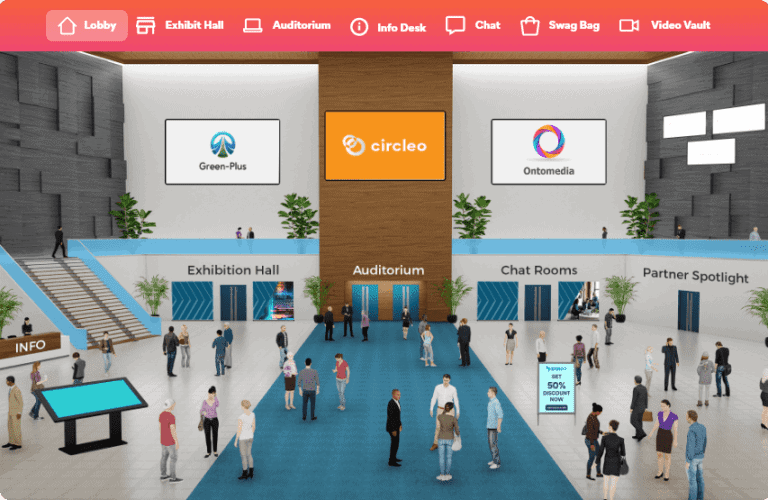
4. Networking Chat Rooms
Questions about audience engagement and network opportunities have been a challenge for virtual and hybrid events. To make sure both the audiences are equally engaged and have similar experiences, planning is essential. For the virtual aspect of the event, interaction needs to be planned, well explained, coordinated and intentional.
Networking chat rooms are the ideal solution for hybrid and virtual conferences. Virtual audiences can easily lose connection after the stream ends whereas in-person attendees can network or visit the exhibition stands. Therefore, for the virtual audience it is essential to plan activities to keep them engaged as well.
Communicating and connecting face-to-face keeps both the audiences interested and willing to participate.
Group chats allow attendees to search, connect and network with other attendees based on expertise, common interests, and job titles.
Here are all the ways attendees can chat and network with each other:
- Breakout Rooms: Breakout rooms are small groups designed to help attendees network with one another, or discuss certain subject matter more in-depth. Attendees can enjoy a more personalized virtual event experience with breakout rooms. These rooms help virtual attendees have discussions after the session or a module ends. Each group is assigned a group discussion leader who records conversations, manages the advanced controls, and monitors polls.
- 1:1 Text Chat: Attendees interact with exhibitors, fellow attendees, and admin through 1:1 text chats. These private conversations can act as a bridge between the virtual and in-person attendees, as in-person attendees can also access the virtual event through their mobile phones while onsite.
- 1:1 Audio/ Video Chat: 1:1 Audio and Video chats can be great for interviews, sales discovery calls, and more.
- Group Chat Rooms: Group chat rooms are assigned to each group on the event. For example, some of you might like to have a group chat room for all the attendees – in-person and virtual. Visitors at a specific booth can have one for themselves. Hosts can also have themed chat rooms for specific events.
- Ad-hoc Text/ Audio/ Video Chats: Ad hoc chats, be it through text, audio, or video, can be extremely beneficial for attendee networking. These chats let attendees set up their own chat rooms and start conversations with whomever they invite. This gives them the liberty to have detailed conversations with whomever they want.
- Moderated Q&As: Moderated Q&As offer a great deal of clarity. Attendees can submit their questions to a booth and booth representatives can decide whether they would like to share the answer publicly.
5. Analytics & Reporting
Hybrid event analytics need a coherent approach from organizers to interpret, investigate and report data from both virtual and in-person components.
Virtual Event Analytics
Virtual events offer in-depth data that goes beyond visitors’ attendance. With the detailed, perceptive graphs, virtual events data covers items such as event registration, logins, webinar and exhibit booth traffic, chat metrics, and other engagement data.
The data analytics are mostly available within the dashboard of the virtual events platform and can be easily exported. These analytics allow immediate monitoring of attendees’ behavior and assist with post-event reporting for the organizers.
In-Person Event Analytics
In-person components of hybrid events are mostly small since large gatherings are not a possibility. Therefore, organizers often center on collecting attendees’ feedback on-site. This helps establish whether the event was satisfactory or had exceeded expectations.
An NPS score is also a good substitute for evaluating attendee satisfaction. Hosts can send emails to the attendees who checked in on-site and ask them to provide feedback through NPS scores or quantitative feedback surveys.
Also, installing systems such as HappyOrNot can help hosts gauge the satisfaction of the attendees. These systems offer deep insights and analytics that can be extremely fruitful.
They allow you to set targets, evaluate patterns, and forecast future performances. With such tools, hosts can utilize those results to collaborate in real-time to fix issues, and improve performance based on the data.
Footfall sensors and spatial analytics are good indicators of attendee engagement. Event organizers, thus, build quantitative performance reports to optimize the in-person experience.
In conclusion, virtual event analytics are considered in-depth and more accurate as compared to on-site ones. For hybrid events, data-driven event platforms can prove to be a significant solution, allowing centralized reporting from in-person to virtual audiences.
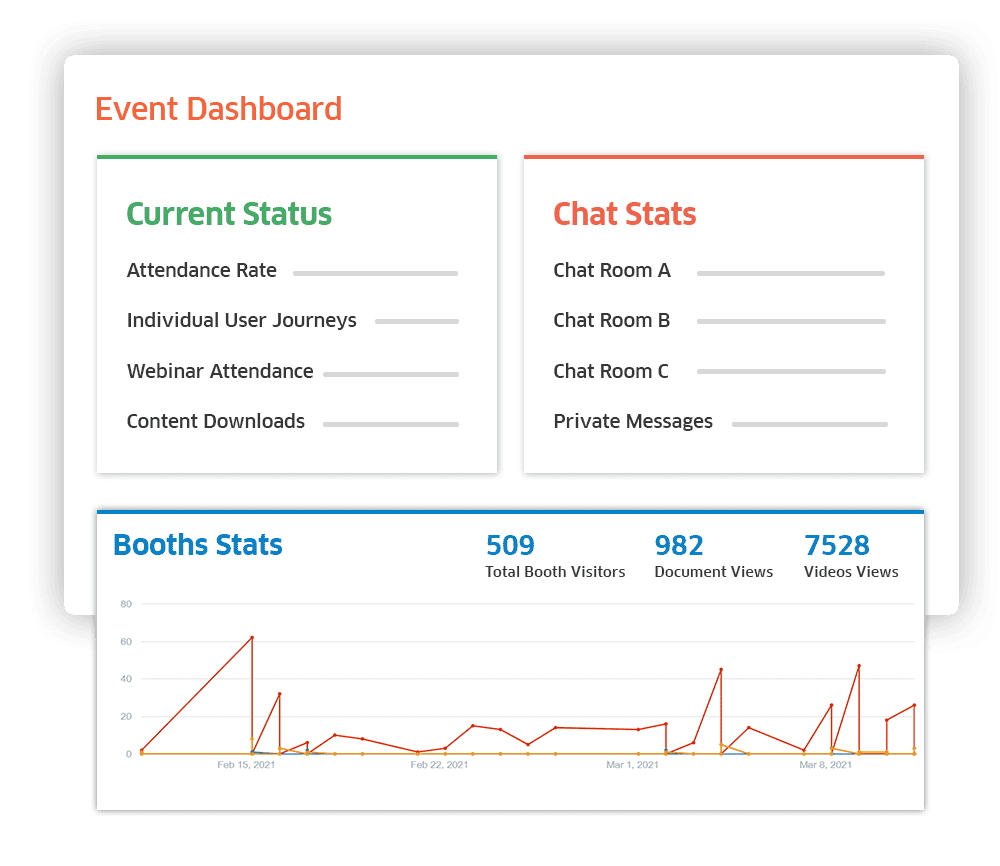
6. Mobile App
An event mobile app is essential when aiming to deliver a seamless event experience. The mobile app can be used to connect the attendees, both in virtual and in person sessions, to form a community. Attendees can share videos, images, thoughts, and experiences with each other.
They are given the opportunity to build profiles with their photos, interests, bio, and thoughts. Profiles can help individuals with similar interests to form strong connections.
In many cases, mobile apps provide features such as questions, polls, and the ability to measure attendee satisfaction, engagement, and return on investment.
The aim of an event mobile app is to offer both types of attendees a personalized experience with venue maps, exhibitor information, speaker bios, and notes in the app.
Cost & ROI
When planning a hybrid event, it is important to consider that you need to make arrangements for two venues – a physical and a virtual one. Therefore, you must take into consideration all the costs for the respective venues. This is what the line items and cost of each aspect would look like:
*cost is a rough estimate for an event of about 100 people. It may vary depending on the type of venue, décor, event management, catering, etc.
One of the most important benefits of hybrid events is the increased reach. Hybrid events are rich in data, sustainable, inclusive, and dynamic. They have the potential to offer greater ROI for hosts, and a mesmeric experience for the attendees.
Following are a few factors that you might consider for hybrid events ROI:
1. Onsite Encoder
With a virtual experience, you can increase the ticket sales, brand awareness, leads, and ticket sales. Onsite encoders are the ultimate way to broadcast live presentations to the virtual audience.
To achieve a higher ROI, an on-site encoder is needed. An on-site encoder is the link between the virtual and in-person audiences and provides room to a much larger audience.
2. Camera Operators
The event footage is essential for a greater ROI after the event. Investing in camera operators for your event streaming will serve as the beginning of ROI for your content. Your event sessions can be turned into gated content which can attract leads.
Marketing team can also turn it into a preview that could increase the attendance for the next event. The content could additionally be used to optimize a keynote for YouTube search to increase brand awareness.
3. Hybrid Event Planning
When planning a hybrid event, it is essential to take into consideration the costs and the ROI. In order to maximize your ROI, you’ll need to set your goals and plan ahead of time.
When you’ve reached half of the equation, it is crucial to measure the success of the event once it’s over. This will help you find out how successful the event was, what the setbacks were, and how you can improve events in the future.
Event analytics help analyze your KPIs so you can manage the attendees and increase engagement.
4. Sponsorship Opportunities
Hybrid events come with new sponsorship opportunities.
Whether it’s the virtual booths, gamification or clickable banners, hybrid events are full of possibilities. Sponsors are usually provided with options to customize their booths with interactive content to connect with the audience in different ways.
The sponsors have access to all the useful data generated from attendees. This data is valuable to marketers and sponsors as it provides the full picture of attendee engagement. The better the data, the more the hosts can charge for sponsorship packages.
5. Increased Planning Time
Planning hybrid events is time consuming – even more so if it’s your first time. With the need to create one event and two experiences, hybrid events require in-depth planning and resources. The benefit of providing personalized event experiences to both audiences would create a deep impact.
With a great personalized experience, the attendees would remember the brand and will return for more.
Chapter 5: Hybrid Event Benefits
Hybrid events have become increasingly popular in recent years due to their ability to combine the best of both worlds – the benefits of in-person events with the convenience and accessibility of virtual events. Some of the key benefits of hybrid events are as follows:
Benefits for Hosts
1. One Event – Two Experiences
Hybrid events have the ability to offer two experiences to entirely distinct audiences – virtual and in-person. With the ability to provide the best of both worlds, virtual and in-person audiences can enjoy various benefits. They can enjoy social interaction, have access to a virtual platform, perform games and activities, and produce cross-networking opportunities.
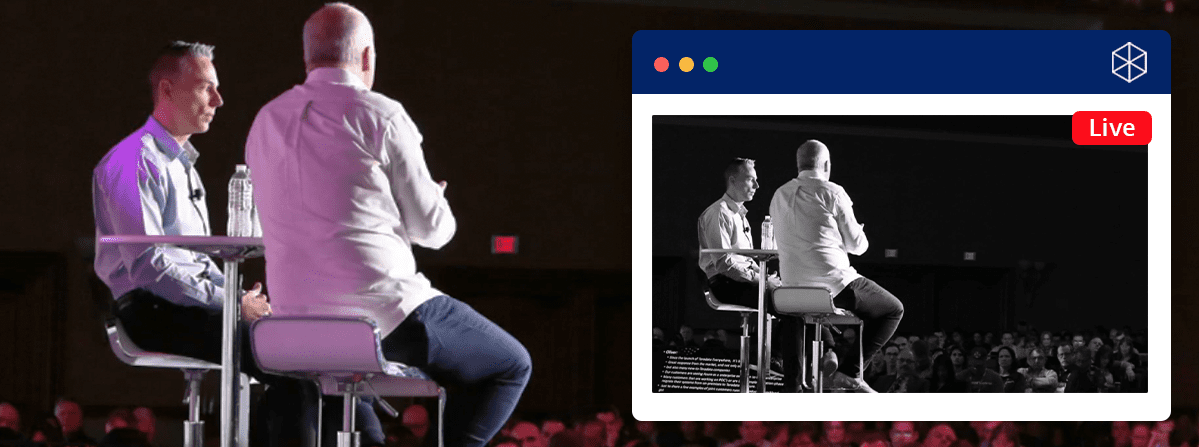
2. Increase Attendance Count
Hybrid approach provides attendees with the opportunity to either take part virtually and in-person, according to their preferences. This approach can provide massive audience reach.
An in-person event will have an upper limit to the number of virtual attendees the organizers can have but with virtual audiences, there is practically no upper limit.
Therefore, you can increase the reach and maximize the capacity of your event to its full potential.
This hybrid combination assists attendees who may have problems being physically present at the locations, to join virtually through an online platform.
3. Measurable Results
Hybrid events technology comes with the ability to collect valuable data and insights from in-person and remote attendees. Remote and in-person attendees can provide feedback through polls, questionnaires, and surveys.
Consolidated feedback is more easily collected with a mobile event app.
Goals and analytics solutions of the event can provide the event organizers with in-depth data-driven insights that can be used to better understand the attendees’ behavior.
With measurable results, the organizers or the hosts have the opportunity to improve their events from time to time based on this feedback.
4. Delight Sponsors
With massive audience reach promised by a hybrid event, sponsors are also at an advantage. Sponsors get extra exposure for their brand, on two diverse platforms that will both benefit them equally.
Sponsors can also participate in the virtual event by setting up virtual event booths and therefore, giving presentations through video conferencing. Moreover, sponsors are attracted to the digital component of the event where they can market and advertise their own brand.
A few popular options you can offer sponsors are:
- exhibiting at your in-person or online trade show, or both,
- showcasing their brand through in-person and digital signage placement,
- hosting speaking sessions such as presentations, webinars, or panels,
- conducting breakout sessions or workshops,
- brand visibility in games such as scavenger hunts, leaderboards and photo booths, and
- including a branded swag item in your event gift bag.
5. Facilitate Audience Feedback Online
Hybrid events provide a greater return on investment (ROI) because of the massive reach and scalability of the event. This leads to more attendees, more sponsors and more business for you!
Furthermore, it leads to an increased lead generation for the exhibitors as well.
Hybrid events provide you insights to the event including audiences’ behavior patterns and interests. You can easily track the digital footprints of the virtual attendees which helps them gain a greater understanding of their behavior.
Attendee feedback can also be taken through the virtual platform which makes it easier to analyze, interpret, and record attendees’ behavior, preferences, and feedback about the event.
Benefits for Attendees
Hybrid events have revolutionized the way attendees experience gatherings, offering a host of advantages that cater to diverse needs and preferences. These benefits not only enhance the attendee experience but also open up new possibilities for engagement and interaction. Here are some compelling reasons why attendees should be excited about participating in hybrid events:
1. Flexibility and Convenience
Hybrid events provide attendees with the ultimate convenience. They can choose to attend in person, allowing for face-to-face networking and immersive experiences, or join virtually from the comfort of their homes or offices. This flexibility accommodates varying schedules, eliminates the need for extensive travel, and ensures that attendees can participate regardless of their location.
2. Expanded Access
Hybrid events break down geographical barriers. Attendees can connect with a global audience, gaining exposure to diverse perspectives and insights. This expanded access to a broader community of participants enhances networking opportunities and fosters valuable connections that might not have been possible in a purely physical event.
3. Customized Experience
Hybrid events often offer attendees the ability to tailor their experience. They can choose which sessions to attend, whether in person or virtually, based on their interests and preferences. This level of customization allows attendees to maximize the value they gain from the event by focusing on content that matters most to them.
4. Cost Savings
Virtual attendance can significantly reduce the overall cost of attending an event. Attendees can save on travel expenses, accommodation, and other associated costs, making it a more budget-friendly option without compromising on the event’s educational or networking opportunities.
5. Inclusivity
Hybrid events are inclusive by nature. They accommodate individuals with disabilities or health concerns who may have difficulty attending in-person events. This inclusivity promotes diversity and ensures that a wider range of voices and perspectives can be heard and valued within the event community.
6. Extended Engagement
Hybrid events often extend beyond the event dates. Attendees can access recorded sessions, downloadable resources, and interactive platforms post-event, allowing them to continue learning and connecting long after the event has concluded. This extended engagement enhances the overall value of the event experience.
7. Reduced Environmental Impact
By reducing the need for extensive travel and physical infrastructure, hybrid events contribute to a more sustainable future. Attendees can take pride in participating in an event format that aligns with environmental goals, reducing their carbon footprint.
What Value Do Hybrid Events Provide?
If your organization carries out successful physical events, the benefits of adding a virtual extension to them are endless and here’s why.
1. Your event attendance and productivity shoot by 20% and 27% respectively (Frost & Sullivan)
For all those who fear that the option to attend the event online might cannibalize their physical event, this is a great myth buster. Virtual extensions have quite the opposite effect because they help you catch attendees who would not have been able to make it to the physical premises. It also captures passive attendees from close by or far away who did not see a lot of value in attending the physical event and would rather participate from the comfort and convenience of their homes.
There’s no way that you can lose out on an audience by providing a more convenient mode of participation and rather by giving passive attendees a taste of your compelling content online, you boost their chances of attending the upcoming physical event.
2. Event technology reduces costs by 20% – 30% (Frost & Sullivan)
Physical events already require a lot of resources, money and time, so rest assured that virtual events will not be contributing to the weight. By adding a digital extension, you’d lower the cost per attendee and would also save a portion of your audience travel costs, which could have been a reason that limited their physical attendance.
3. They allow data-driven lead tracking
Virtual events track each registration, login, chat, view, download, and share. These numbers are very useful in determining the number of people who attended the event and the quality of their engagement and experience. Being able to monitor the level of engagement of event attendees makes post-event follow-up easier since you can segment people based on their engagement scores and share relevant content with them which is far more potent in capturing leads as compared to a standardized follow-up strategy.
4. You can keep driving ROI long after the live period
The most distinguishing benefit of virtual events over their physical counterparts is that once the live days are over, the virtual event can still live on. By making your webinars and content available on-demand, you can extend the life of your event which further boosts event ROI by allowing you to get the most out of your content, extending lead generation and extending opportunities for monetization.
Chapter 6: Hybrid Event Planning
Before you plan the hybrid event, it is essential to finetune the initial details. Following are the details that put you up in the right direction when you plan hybrid events:
Clear Goals & Objectives
Event goals and objectives are crucial to the success of the event. Without a purpose, the event cannot deliver. Following are the questions that one should ask as an organizer:
- Why are we hosting this event?
- What do we want to accomplish? (i.e., build brand awareness, educate attendees etc.)
- What unique value(s) can we provide our audience with?
- What value can we provide for your sponsors?
- What are the different expectations each audience will have, and how can we help fulfill those as well?
Keeping the purpose in mind, goals and objectives for the event can be defined. Later, KPIs to these objectives can be assigned to measure the success of the events.
You need to keep the principle of defining objectives in their mind. You need to have S.M.A.R.T goals.
Time Zones & Event Venue
The most important part of hybrid event planning is deciding on the time zones and the event venue. Since hybrid events must cater to two distinct audiences – on-site attendees and live attendees – choosing the right time zone is a very critical decision to make.
In most cases, time zones for the virtual audiences are entirely different. However, if the target audience for the virtual component is in a similar time-zone than the event location, there is no challenge and webinars can be planned based on that singular time zone.
Another way of dealing with different time zones is by running multi-sessions so the attendees have the opportunity to choose which sessions work best according to their time zones.
When thinking about event venues, virtual attendees will attend their session on the virtual events platform. The venue becomes a challenge in the case of the in-person sessions.
If in case any of the on-site attendees fails to show up for the event, they will be given an opportunity to attend the event virtually.
Creating Personas: Speakers, Sponsors & Community Partners
While there may be various approaches to identify your target audience, the basic and the foremost approach is to understand which is the most ideal audience for the event. Identifying your target audience can help you achieve the event’s objectives, provide a commendable attendee experience, and receive positive feedback.
One of the biggest factors in determining the success of the event is to not only understand your target audience but also learn about their behaviors, needs, and expectations from the event.
The winning factor will be to learn how to convince potential attendees to attend your event.
Therefore, developing and creating personas are essential. Personas are an imaginary model of the ideal target audience completely based on market research or from the data retrieved from the past events.
Personas are critical and therefore must be as detailed as possible and should include the following information:
- Demographic data
- Geographic location
- Industry sector
- Job role
- Online activities and media consumptions
- Pain points
- Technology they use
- Accessibility needs
Personas of speakers, sponsors and community partners will help you understand all the different sets of people connected with the hybrid event. The clearer idea of the target audience, the better they’re able to design a hybrid event that suits their needs and preferences.
Budgeting
As an organizer, it is important to assign a budget to each of your costs such as the venue, virtual events, speakers, food and beverages, equipment etc. Having a budget will keep you on track when finalizing the platform providers and the vendors.
Hybrid events have various stakeholders including speakers, exhibitors and more. Therefore, accumulate and gather all the data in one place to refer to when needed.
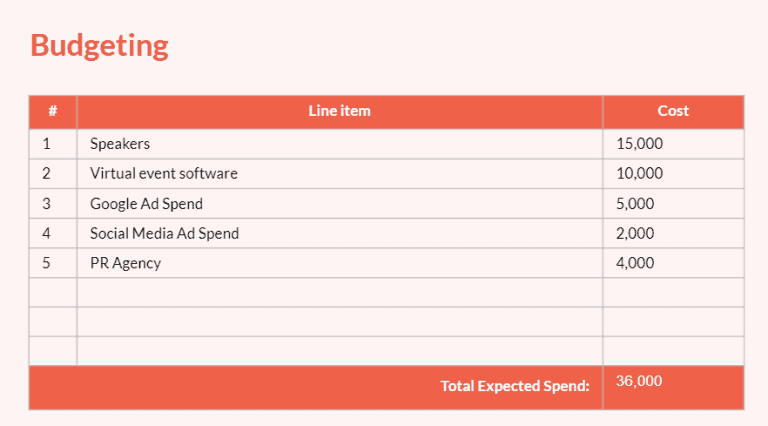
The budget can vary depending upon the type and the size of the hybrid event, but here are a few items that would be included in the list:
- Rent for the venue
- Stage, decoration
- Marketing and promotions
- Staffing, including volunteers’ accommodations
- Catering
- Event technology (event management solution, virtual event platform, etc.)
- A/V equipment (speakers, mics, live streaming equipment, etc.)
- Equipment and furniture rental
- Signage, branding, marketing collateral
Once the budgeting is clear, you can have more options and ample time to negotiate with vendors, and speakers.
This can provide you with a clear roadmap to make sure the hybrid event stays within the budget.
Hybrid Event Platform & Technology
Since hybrid events provide two distinct experiences, it is important to analyze whether you have the suitable event technology to execute a great hybrid event strategy.
When deciding on software options, it is essential to choose the option that includes interaction, networking event engagement and more.
It is important to focus on features such as:
- robust networking features
- integrations with a wide variety of apps and platforms
- excellent customer support
- gamification
- video and group chats
- breakout sessions
- live chats and polling
- interactive sponsorship and exhibitions
- fully customized branding
The ideal hybrid event solution would include the virtual events platform and the mobile event app in one solution. Such a platform would provide the attendees the opportunity to interact with each other, regardless of whether they are virtual and on-site attendees.
Here are some common technology tools to consider for hybrid events:
1. Registration and Ticketing Platform
It’s important to start with a technology solution provider that allows you to sell tickets and manage online registrations virtually. Some virtual events companies also offer built-in registration features.
2. Mobile Event App
Mobile event apps are essential for hybrid or virtual events. With an event mobile app, you can enhance the attendee experience. With the event schedules available on the app, the attendees can easily cooperate and network with other attendees, event sponsors and exhibitors.
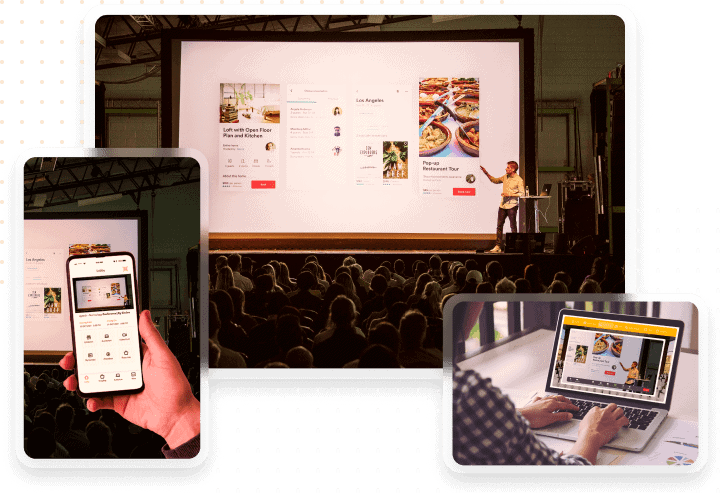
3. Live Streaming Feature
Live streaming solutions must be based upon the organizer’s budget and the event’s needs.
4. Productivity Tools
To have a successful hybrid event, you need to invest in project management software and other productivity tools to help them streamline their team’s collaboration.
5. Attendee Engagement Tools
Attendee engagement tools include, social media wall, event gamification tools and more that can increase the guest experience.
The right tools clearly depend upon the unique needs of each hybrid event and the goal behind it. These tools might not be used in every case; however, they are essential for most hybrid events.
Branding & Messaging
To market the hybrid event, a detailed list of the collateral is important. A lot of branding material is required to fulfill the needs of both the in-person and online events.
In the case of outdoor advertising, arrangements are to be made in advance.
In order to ace your marketing and advertising for the hybrid event, a spectacular content plan is essential. It is crucial to push out the relevant data before, during and after the event to target the audience at the right time.
The part of the event that makes the most impact is the pre-event marketing. As a marketer, it is vital to build anticipation for both in-person and virtual attendees by letting them know what they should exactly expect from the event.
Moreover, the purpose of marketing and advertising is to make them feel as engaged as possible so they may have a similar experience to the live attendees.
Since it is important to cater to both the in-person and live attendees, it is important to target both of them separately.
You should market the in-person component of the event by focusing more on:
- The venue
- Networking sessions
- Exhibitions
- Entertainment
- The ambience of the event
- Unique selling point (USP) of your event
For the virtual component, focus more on:
- Quality of the live streaming
- Collaborative networking tools
- Advanced technology
- Takeaways
A best practice is to make a clear outline of the distinctive and common features to the two audiences so they would know what to expect of the event. This way the attendees can plan for which sessions are the most interesting to them so they may schedule their event accordingly.
Download The Ultimate Guide to Hybrid Events here.
vFairs Hybrid Event Planner
Just as you would plan your physical event, you would plan hybrid events. This includes making an exhaustive list of tasks, and assigning responsibilities and due dates. With so much to be sorted, this hybrid events planner helps you:
- consolidate all planning and execution details in one document
- minimize any chances of losing precious information
- track due dates, responsibilities and status of each activity
- stay on course with your planning and execution of each item
You can create a planner, or use the one we have created for you before the event starts, outlining each aspect of the event. As previously discussed, hybrid event planners promise to make your life easy.
Moving on to the vFairs hybrid event planner itself, let’s see how it takes you through the entire planning process. The sections have been divided according to the event phases. Majorly before and after the event.
Diving right in.
Arrange Rehearsals
Your speakers might want to rehearse their parts or get familiar with the environment and the setting. Both virtual and live speakers will need to run through their parts. This is so they can time themselves and get used to presenting in front of a camera. These rehearsals can assist them and make the live session easier for them.
Set up A/V for Live Streaming
Keep an A/V team present on site which can assist in streaming speaker sessions to the online audience. It can even help in setting up the virtual speaker sessions ensuring everything is in place and there aren’t any last-minute surprises and glitches.
Whether you want to broadcast live to the virtual audience or upload a recorded session you will need multiple cameras and a seamless audio/video setup. You might need to consider a multi-camera setup with DSLRs, webcam, and mobile phones connected to the streaming software.
Chapter 7: Hybrid Event Marketing
Promote On Your Site
Marketing the hybrid event on the website plays a very significant role in attracting the right prospects.
To market hybrid events right, a landing page is needed. A landing page provides a registration form for the prospects to sign-up for the event. Therefore, it is important to have a landing page that serves the purpose and is attractive and striking enough to inspire the prospects to sign-up for the event.
Following are some of the items a hybrid event landing page must have:
- All the relevant details about the hybrid event; what is it about, the location of the in-person portion, when will it be held, and who is it for.
- Eye-catching imagery and graphics can leave a great impact.
- A registration form that is precise, clear and easy to fill.
- A well-put call to action that persuades the attendees to click.
- SEO optimized content with relevant keywords.
- Frequently asked questions to help address any prospect’s concerns.
- A place for sponsors and exhibitors to contact your team or purchase a package (if applicable).
Even after the prospects have signed up, they will still need the web page to look for further information regarding the event.
Another technique for event promotion is promoting the speakers to the fullest. There is no stronger pull than an influential speaker lineup. Therefore, showcasing the speakers at the event is a spectacular way to increase the number of attendees.
Interact on Social Media
Just like many other events, social media can prove to be a valuable way to promote a hybrid event. Social media is the only way to reach remote attendees in masses. Social media marketing plans, therefore, must be very well-formulated for it to be effective.
Account takeovers by speakers, sponsors, and exhibitors is a terrific way to use influencer marketing to promote the event. With personal and two-way communication with the audience, social media creates the required buzz before the event. Share the speaker details, the agenda for the event, and the testimonials from the previous attendees to build trust.
Hashtags play an important role to pull the conversation together and provide the prospects the opportunity to learn more about the brand and the upcoming event.
A branded hashtag can prove to be a valuable addition to the promotion campaign. The attendees can use it when creating social media posts about the event. It is essential to attract attention to your event and give it a feeling of a community.
Creating a branded hashtag can help organizers achieve that.
Well-designed banners on social media platforms can bring a lot of attention to the hybrid event. Use social media platforms to the fullest to create the hype before the event, talk about the importance of it during the event, and share how successful it was after the event.
Here are some exclusive social media tips you can use to interact on social media:
- Create buzz on native social media channels with a clear call-to-action (CTA) for event registration
- Incorporate social media wall within the event
- Create shareable digital assets for speakers and participants. This includes pre-event and post-event hype such as rewarding participants with badges or sending them virtual gift bags.
- Add social media links to all other marketing channels such as emails, landing pages, and websites.
- Add a “Share to invite others” CTA button with social links right after the registration of the event.
- Change cover photos on social media channels frequently.
- Target people in the respective industry, based on interest, and behaviors through paid ads.
- Incentivize registration by offering giveaways to the first 100 attendees. Create a social buzz around that before the event.
Opt for Paid Media
Paid media ads can quickly promote hybrid events with Google ads. To see rapid improvements in the hybrid event registration volume, it is vital to invest in paid advertisements. Higher traffic is a fundamental step to entice the identified audiences online. The targeted campaigns that reach out to the right audience makes a strong impact.
Demographics and geographical locations assist in building awareness and the event’s visibility on search engines. It is essential to make actionable ads that will out-do the competitors and attract traffic and registrations.
Ads also help to easily measure and assess the effectiveness of the paid ads via clicks and conversions.
With analytics, you can get insights on the ad performances based on various key metrics that aid the market strategy. Investing into websites and ads is the easiest course to get the highest traffic to the events registration/ landing page.
Leverage Email Marketing
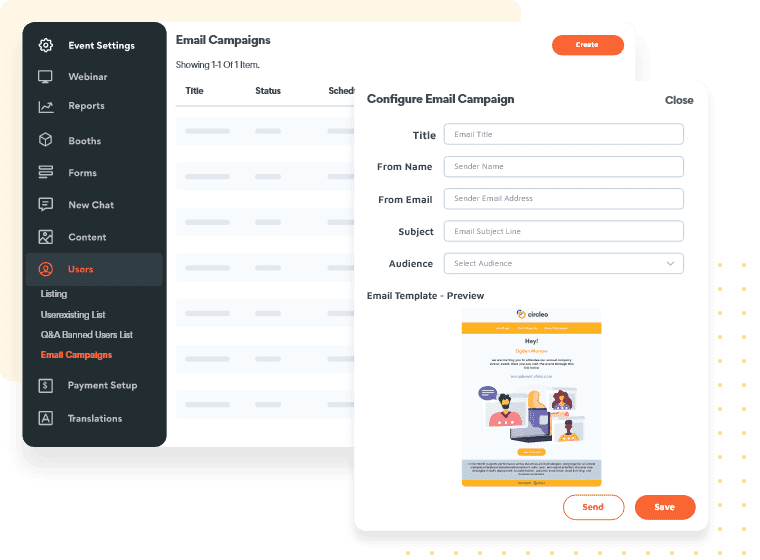
Just like social media marketing, email marketing is a core element to market any hybrid event right. A sequence of emails with the right content and attractive visuals can persuade the existing subscribers to re-subscribe and encourage the new ones to do the same.
Creating a proper email marketing strategy can be crucial, and therefore, you as organizers and marketers need to keep the following points in mind:
- Determine the right target audience
Use your CRM to fetch data from existing contacts and analyze it to learn more about your leads – demographics, likes and dislikes — the pain points they are trying to solve.
- Decide on the number of emails and the delays in between
You’ll need a dedicated drip campaign for your event. Look at how frequently your readers expect to hear from you or use data to see how often they interact with your emails. As a standard, you can start promotions 3 weeks prior to your event and send two emails every week. Each email will reveal more information about the event.
Add 2 or 3 day delays between each event. You’ll see most of your registrations come through during the last week of promotions so make sure these emails pack a punch.
Send your final promo one day before the event.
- An attractive and compelling subject line
Great subject lines are short and sweet, preferably between 4 – 7 words. Therefore, remember to make recipients feel important, invited, and exclusive with the subject line.
Make sure your subject line isn’t misleading. It should reflect the promotion of an event so it shouldn’t feel spammy. Use some examples of popular subject lines with open rates to ensure you’re on the right track.
- The body text that delivers the right message
Reveal all the important details in the body. What’s the event about, and who will be attending? What’s in it for you? Where will the live event be? Where will the virtual event be hosted?
- A convincing call to action
Offer a link to the main landing page, and make it compelling. Examples include, save my spot, book a ticket, send me my ticket, etc.
- Conducting A/B testing for the email campaigns
Testing will help you optimize future campaigns. You can put forth a hypothesis that you believe could improve results such as adding a GIF will increase clicks. It is a good idea to create two versions; in this instance, you could create one with a static image and one with an animated GIF. Track their clicks, and choose a winner.
Email marketing campaigns have a different approach to target the right audience. The focus of the email marketing campaign should primarily be on the recipients and to invite them to the event.
It is prescribed to keep the campaign completely dedicated and specific to encouraging the attendees to register for the event. Therefore, filtering the recipient lists can help you target them better.
The emails should be able to provide complete details of the event and a set of instructions for the registration. Sending one or two reminders near the event would help them keep the event on top of mind.
Content Marketing
Content marketing serves as a promotional powerhouse for the marketing of any event. The right content can serve the purpose of attracting visitors to the hybrid events landing page with the use of guest posts and highly regarded blogs.
The best advice for a hybrid event organizer is to turn their content into a gold mine.
One of the greatest benefits of hosting hybrid events is the content that is gathered during the event. All the speakers, sponsors, and presenters featured at the event have been the ultimate reason to provide valuable content to the attendees as well as for those who could not attend.
These speaker sessions or talks can be integrated with website content or be featured on social media to promote the upcoming event. The event platform providers can help you transform their event into a virtual library.
This digital space gives the organizers the ability to distribute the content and dispense it according to their preferences.
Therefore, content must have quality, relevance, and clarity. The more engaging the content, the better the results.
Here are the types of content that make a difference with content marketing:
1. Blogs and Articles
Blogs or articles that resonate well with the target audience helps pull in healthy traffic for the event. Therefore, an article or a blog that provides genuine value to the audience base makes a great impression.
It can be a win-win situation for the brand and the attendees if the useful blog or article has a line or two about the upcoming event.
The content, however, does need to be SEO optimized. Using the right keywords in the article or the blog, and ensuring on-page SEO requirements are met, are of utmost importance.
To make sure the content ranks on Google, it is important to use the right keywords in the content that would help generate organic traffic. This can be a cost-effective method to generate conversions on the landing page.
Another way to create awareness about the content put up on the website is to promote it on social media. This helps to spread the word and pulls in organic traffic.
2. Video Content
Video content, be it on social media or the website, can work well to engage the prospects. Teaser videos can help build up anticipation about the event and create the much-needed hype. Such videos can be short and can hint towards a big reveal at the end of the video.
Gradually, the marketing team can announce the event, release some more details, and keep building the anticipation with more short videos at relevant stages.
Videos with speakers interviews and discussion about the content of their sessions would attract new prospects. Snippets of the venue and any past events catered by the brand can help give prospects an impression of what to expect.
The videos, however, do need to be optimized for YouTube and other channels it will be posted on.
It may be possible for many people to not be able to attend your event. On-demand content can be equivalent to giving them something valuable that would give them a taste of why they should be attending the next event.
It is important for you to remember that the content you have is of great value and is worth charging for. You can charge different rates for people who signed up for the event and for those who did not.
Even though visuals are a good way to go about it, videos are known to be the most impactful. Depending upon the event, a mix of entertaining videos and educational ones can do wonders.
Snippet videos are always preferred. However, it would be fruitful to release a mix of both short and full-length videos with speakers’ content.
Another idea could be providing subtitles to the event videos and snippets so the content is clearer, impactful and interesting.
3. Content Partnerships and Backlinking
Content partnerships & backlinking can help you reach out to partners or brand advocates. They can assist you further by reaching out to the right audience to see if they’re open to a content partnership, link exchange or promotion of your event on their channels.
Here’s how content partnerships work:
- Brands work together to create shared content and subsequently, both the parties promote it amongst their audiences.
- Your brand works on a piece of valuable content and you partner with another brand to promote it.
- Your partner works on the content for you that would promote your brand.
Brands collaborate with other brands for content partnership mainly for two reasons – to expand their reach and to receive benefits of SEO and backlinking. Make sure when pitching a partnership that you can also deliver that value back to the company you want to work with.
4. Social Media Marketing and Emails
Social media marketing and email marketing campaigns are what makes or breaks the marketing for the hybrid event. Creating a buzz on social media and sending appropriate emails to potential clients through email marketing is a great technique to advertise the event before it happens.
Following are the types of content that goes into consideration for each event:
Social Media Content
Social media content requires detailed planning of how to distribute content effectively. Therefore, it is important to segregate it into pre, during, and post-event buzz.
This works as a magnet for the target audience and helps you collect registrations. Attendees feel connected across channels, and you can easily communicate key takeaways after the event. However, not all items need to be included in all events. You can pick and choose whatever best serves your needs.
Social media content serves as a great communication tool for both on-site and online attendees.
Email Content
Email content plays an important role in developing your relationship with your subscribers. Content is the core of marketing, and therefore, professional marketers benefit from it immensely. Content not only brings in results, but is cost-effective too.
With the right email content, you can organically grow your brand and create a process that directly impacts your sales. You can do this by creating impactful content that people look forward to reading. People who would like your content will be motivated to build a relationship with you and will always consider you when it’s time for them to buy. You’ll be on top of their head.
Onsite Signage and Printed Collateral
Onsite signage plays a crucial role in how an attendee perceives your event. Therefore, it needs to be proper and should be able to advertise your brand in the best possible way.
Printed collateral includes all the marketing collateral provided to the attendees during the on-site event. Examples include newsletters, corporate magazines, products catalogs, branded content, and more.
Online Signage and Digital Collateral
Similarly, online signage and digital collateral is equally important. Digital collateral includes testimonials, case studies, white papers, ebooks, blog posts, and explainer videos.
Online Ads
Online ads are a daily part of a marketer’s life. They play a huge role in targeting the right market, creating awareness, and generating sales. Online ads include Google search ads, PPC ads, Mobile ads, banners ads, retargeting ads, and more.
Outdoor Advertising
Outdoor advertising otherwise known as home advertising, exposes consumers with the brand’s content outside of their homes. Outdoor advertising can be seen everywhere and has the potential to reach millions of people in the most impactful way.
When placed in the right spots where people can easily see them, outdoor ads cannot be bypassed. Therefore, outdoor ads can be a great way of getting in front of the local audiences where the event is being held. This will extend your reach within the given area.
Event Listings
Event listings are events and ticket listings created by sellers that are for sale. These listings include digital content created for a certain event. Some of the event listing sites include Eventbrite, Mainevents, Eventsget, Hook2events, and more.
vFairs also has its own event marketplace named Discover, where you can find top virtual and hybrid event listings to attend, sponsor or exhibit at.
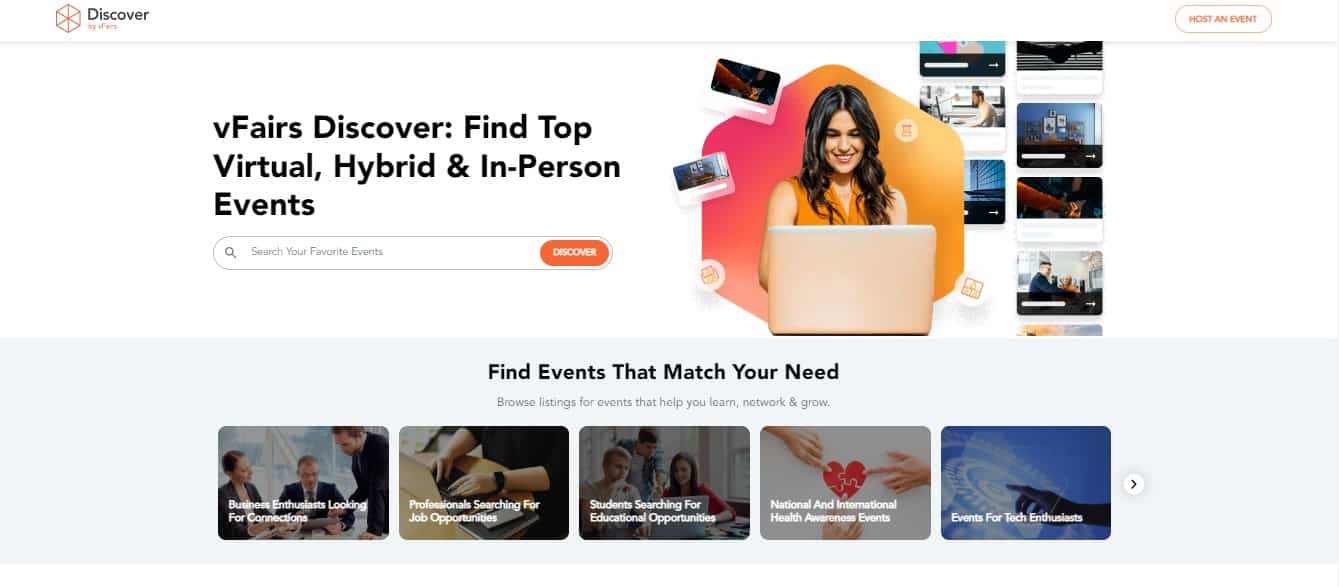
Scripts, Slideshows and Notes for Presentations
Scripts, slideshows and notes for presentations serve as the support guides for attendees. Providing them with all the material will help them understand and look back at the content from time to time.
Virtual Event Venue Designs and Custom Graphics
One of our virtual event venue designs that can be customized according to your requirements.
Virtual event venue designs and custom graphics help you create a unique branded event experience. This is a very powerful tool to increase brand awareness. Just like any on-site event, everyone who attends the event should immediately become submerged to their surroundings.
Therefore, an average looking event won’t do. You’d have to make good use of your brand colors, fonts, and imagery to create a unique branded event experience. Your goal should be to wow attendees from the first glimpse.
You can also create a distinctive event experience with branded menus, home screens, and videos that can create a great impact.
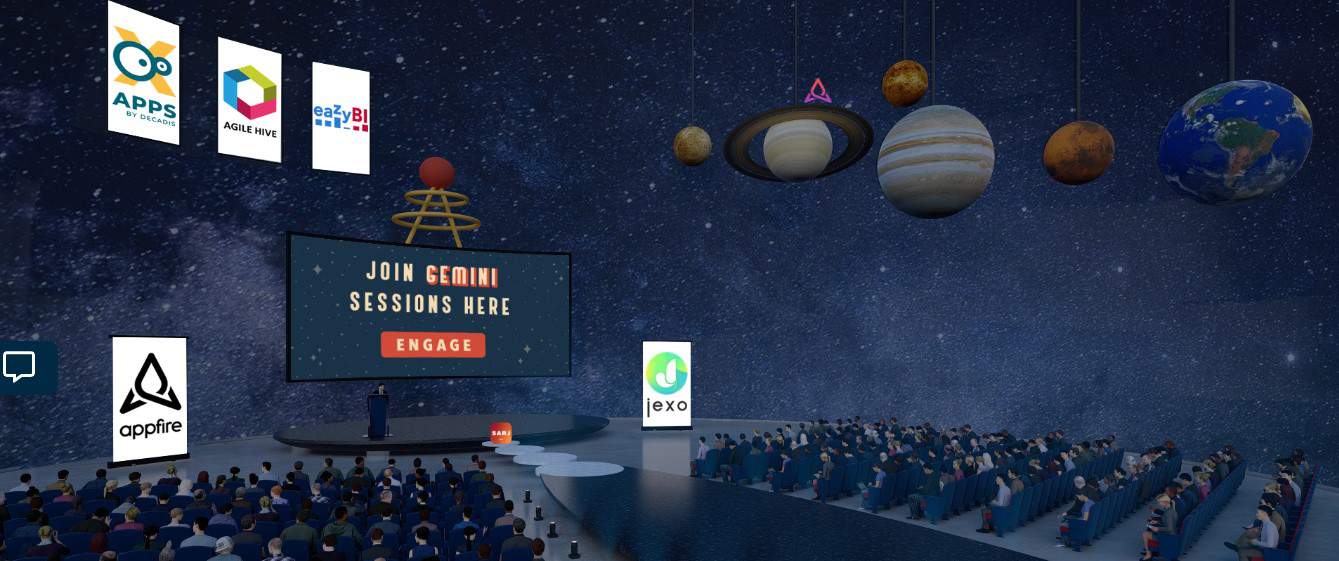
5. Website Items
Following are different ways you can promote your event with website items:
Pop-ups
Pop-ups across your website can also assist with the event marketing. Pop-ups make sure that the new and the returning visitors on your website can learn about the event and be persuaded to sign-up.
Popups at the homepage with compelling call-to-actions can boost the attendee sign-ups.
Sticky bars
A sticky bar is a horizontal bar that you can put up on the top or the bottom of any page on your website. It serves as a website conversion tool and can be beneficial for attracting registrations. It is easily customizable and helps display your message prominently.
Temporary menu items
Menus display a list of items users can access on the website. Menus are easy to open, close, and use. Temporary menu items can help advertise some items or services temporarily and can be differentiated or highlighted to make them more visible.
Blog, articles, and other resources
Blogs, articles, and other resources with the mention of the event serve as a marketing tool where your event is being promoted. By reading the blogs or articles where the success of the event is discussed, potential customers will be encouraged to register.
Call-to-action boxes
Call-to-action boxes can be put up on specific website pages. Preferably, they are placed at site pages with high traffic and relevance to the subject matter of the event.
6. PR
PR and branding are two peas in a pod. PR is equally important as is social media, SEO, and influencer relations. With successful PR, brands can build relationships with potential customers, employees, media, and investors within the industry.
A PR campaign, therefore, is an extension of your brand. While brand messaging focuses on customer’s needs and wants, PR makes sure they’re heard and responded well.
Speakers, sponsors, and the audience are the most important stakeholders of the event. Each of these stakeholders can prove to be highly fruitful for the marketing of the event.
- Leverage the Sponsors
The sponsors of the event can be a great help to spread the word out. When sponsors get on board, organizers should explore other ways to collaborate with them to quicken the marketing efforts.
It is also in their best interest that hybrid events attract relevant audiences and that their sponsorship goals are met.
Therefore, it is important to:
- Convince the sponsors to promote the hybrid event on their social media channels, the website, and on other channels.
- Share emails with their subscriber list to attract the right target audience.
- Write a guest post on the sponsors’ blog to bring the audience to the event’s landing page.
Once again, you need to make sure that they work closely with the sponsors to get the content and the messaging right. The stronger the content of the marketing material, the greater results will reap.
- Involve your Speakers and the Audience
Speakers are the event ambassadors of any hybrid event.
The top secret behind a successful marketing campaign is to make sure that the hybrid event is talked about through word of mouth, online, or through any print media channels.
Therefore, incorporating the details of the special guest speakers at the hybrid event can prove to be a great marketing pull. Spokespeople and ambassadors are the main fascinations of any hybrid event and therefore audiences love to connect with them and hear about their experiences.
Thus, it is absolute for any event marketing strategy to build their marketing plan around the ambassadors of the event. To make it easier for them, pre-made posts and images can be provided to them for accessible social media sharing.
You can further encourage event promotion and inspire attendees to spread the word themselves with different tools that can motivate them to spread the buzz with pre-made content.
Chapter 8: Hybrid Event Engagement
Host Quizzes
Hosting quizzes or live contests can help the engagement surge high. You can divide the audience into smaller groups and can conduct quizzes and contests on the mobile event app. The contest can then be aired on the hybrid event platform.
In-person attendees can perform the quiz in groups with the virtual attendees.
Hosting quizzes and contests is one of the easiest ways to include both the attendees. However, they must have an even playing ground. For that, alternate hand raising between both the types of attendees does the job.
To do this, it is essential to provide tablets or any other devices to the in-person attendees to submit their answers.
You or a chat line monitor can read the questions out to the presenters, so they don’t feel overwhelmed with multiple tasks. You can also be the mediator between the in-person and the virtual attendees.
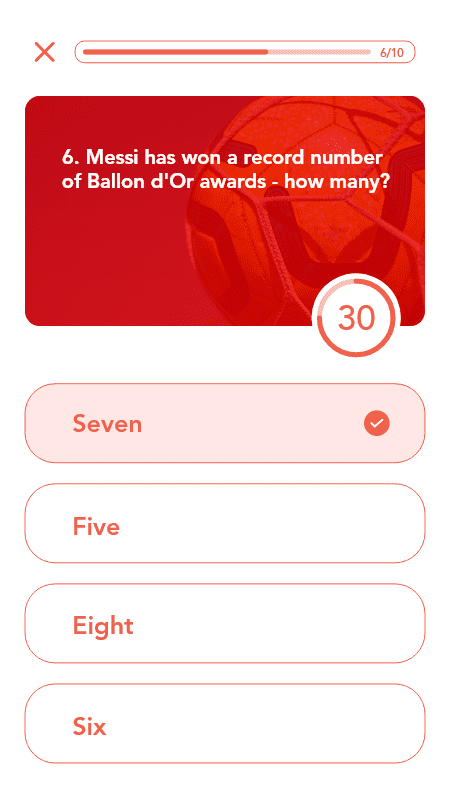
Exhibit Booths
Exhibit booths are where the business actually happens at virtual and hybrid events.
Major leads come directly from the virtual booths therefore, sponsors and exhibitors should never undervalue them. Exhibit booths can be customized according to the exhibitors’ preferences.
Virtual booths come with an option to offer exhibitors the rights to upload videos, photos, branded images, logos, marketing materials, discount vouchers, social media accounts, links to their own site pages, and much more.
However, virtual booths can reflect the on-site ones. On-site attendees can share printed collateral with QR codes linked to similar resources as the virtual booths. These collaterals include PDFs, videos, links to websites, and more, just as they would at a physical booth.
Personalized virtual avatars also contribute a whole lot to the success of the event by humanizing the exhibitor brand and increasing elements of inclusivity within the platform.
Photo Booths
With the ability to personalize, exhibitors can design their booths with the goal of drawing more attendees in and can follow up with a responsive team who can interact through live chats and video calls.
With a virtual booth, attendees can take pictures of themselves and can post them on social media with the events’ hashtag. This helps build a community at different social media platforms and serves as a free marketing tactic to approach a larger audience. These photos can also be uploaded by the hosts in the same online gallery for everyone to see.
The on-site attendees will have the opportunity to take group photos using props and the online ones will feel like a part of the fun as they will be able to see their own pictures in the digital photo gallery.
Breakout Rooms
In the world of virtual and hybrid events, breakout rooms are the focal point of innovative tech advances.
Breakout rooms are the vanguard of keeping attendees engaged and excited about participating at the event. They allow the attendees to have a more personalized and collaborative event experience.
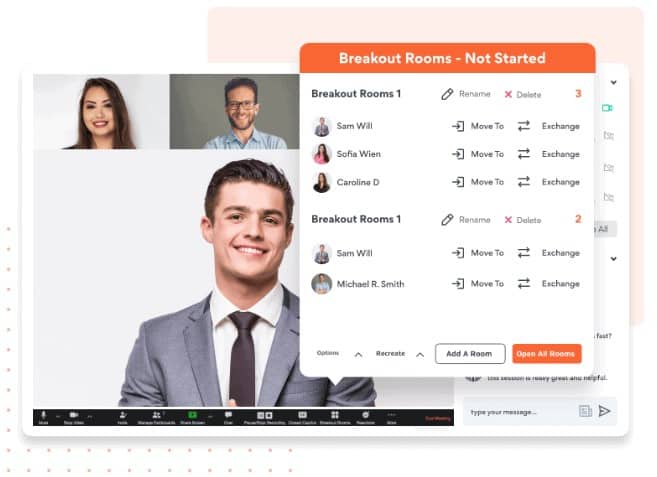
What Are Breakout Rooms?
Breakout rooms are small groups where attendees can have discussions after the speaker, or a live learning module ends. The virtual attendees can have a conversation on what they have experienced and learned during the session.
Each group requires a discussion leader who can make sure to have the conversation in the group going.
The group discussion leader should be provided with advanced controls to mute participants, record conversations, display slide decks and open chat rooms and polls.
How Do Breakout Rooms work?
How a breakout room will work completely depends upon the event platform’s capacities. Therefore, organizers need to ensure that the technology provider can host multiple sessions at once and assist multiple speakers in a dynamic group discussion.
These breakout rooms can easily be arranged by you.
After the group presentations and keynote speeches, attendees can see a link on their screen that would help them join their respective break out room. Group discussion leaders will be in charge of guiding them towards positive and constructive conversation, making sure the technical implementation of the chat rooms, Q&A, and polling are in check.
The virtual events platform providers also offer a team of technical support staff or moderators who administer the technical implementation of these breakout rooms.
After the allotted time for the breakout rooms is over, the attendees are redirected to a larger group at the event. You have the option to bring the attendees in and out of the breakout rooms as many times as they want, throughout the event.
Why Are They Important?
Breakout rooms can create an interactive and engaging experience for both the in-house and virtual attendees alike. They can accelerate collaboration, enhance attendee participation, and provide real-time feedback to the organizers.
Breakout rooms can help attendees network and build a community with this shared experience.
With the conversations in the breakout rooms, the attendees can remember the content and information shared even after the event has ended.
To get the most out of these conversations, it is essential to utilize chat rooms, live polling, and video chats to the fullest. The session leaders can provide information and feedback to the event organizers at the end of the event to let them know how the attendees felt about the event.
Chats
Chats play an important role in bringing the attendees together. Event participants can keep the conversation going with embedded live chats through the chat bar.
Group and private chats facilitate attendees by helping them interact with exhibitors, representatives, and admin. They can get into 1:1 discussions over text, audio, or video chats.
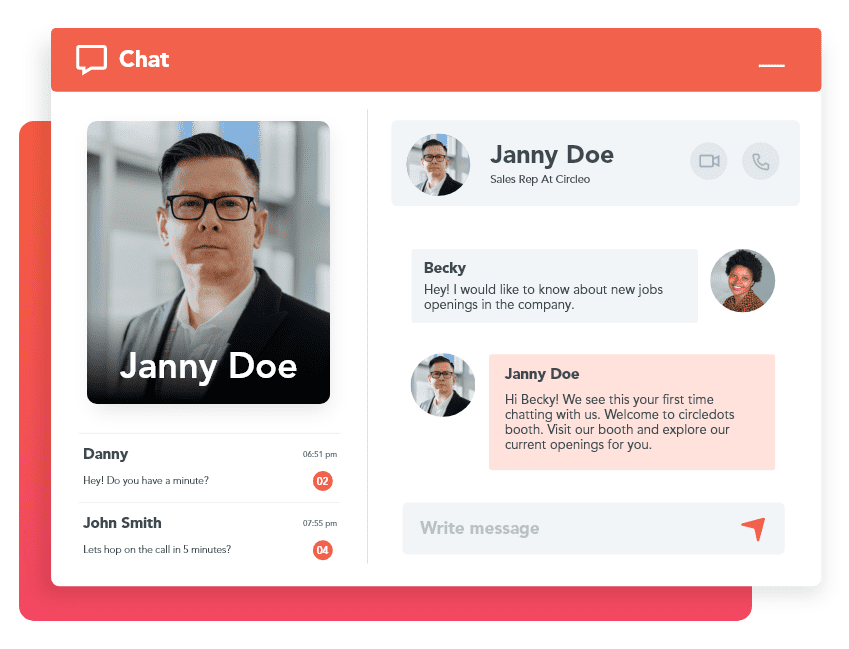
Scavenger Hunts
The best way to make your attendees explore the venue, be it virtual or on-site is by making them participate in scavenger hunts. Offer clues to your attendees and let them find the items to become a top leader on the leaderboard.
Such a healthy mix of activities and interaction can be an appealing activity for hybrid events. Such activities allow the attendees to have some fun during the event and be able to earn prizes and recognition on the leaderboard.
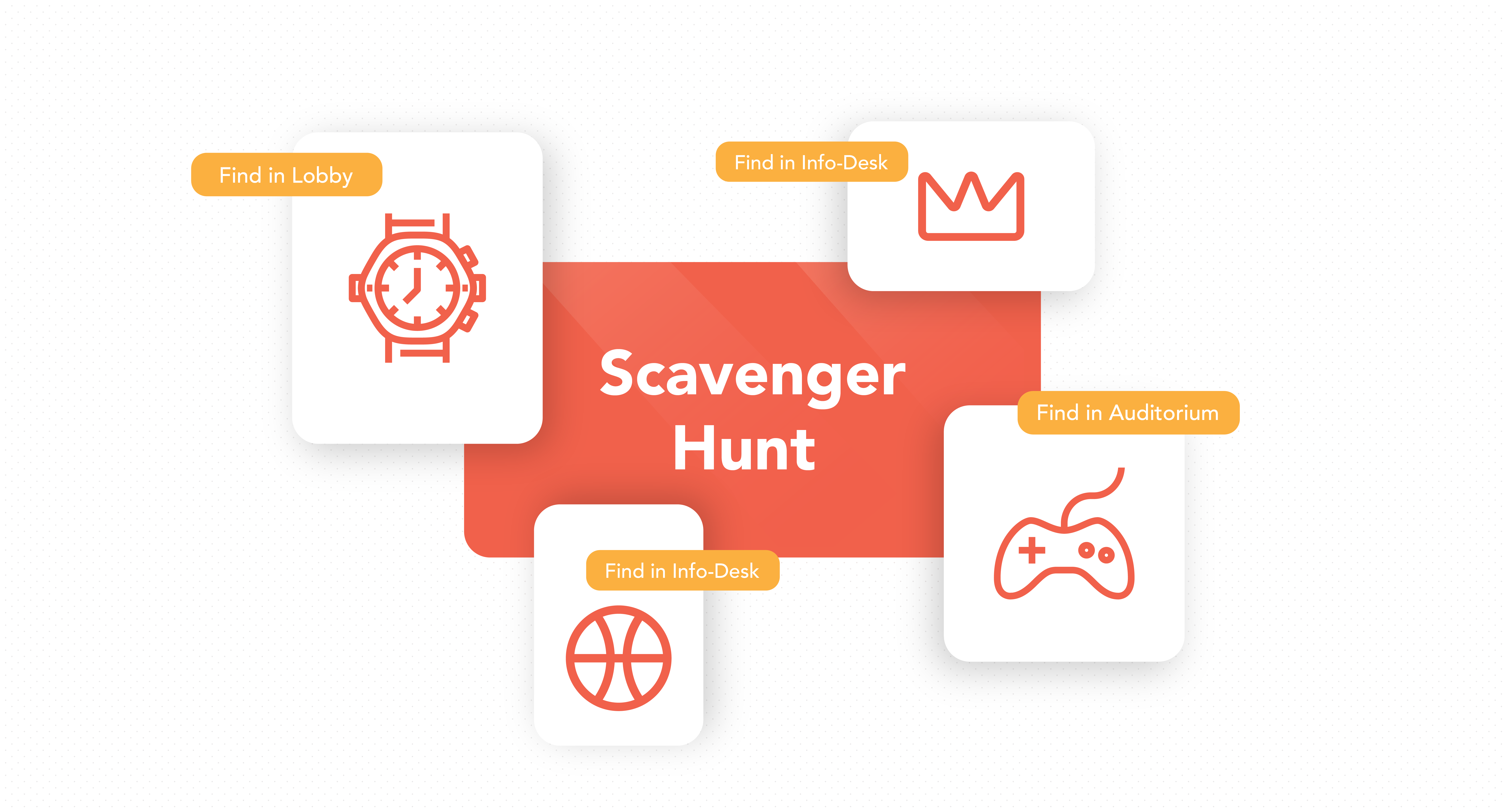
Leaderboards
Leaderboards help award points for attendees who complete specific tasks within the event. Anything can go up on a leaderboard. You can reward attendees for attending a webinar, watching a video, completing a segment, or even for downloading a document.
Attendees with the highest points at the end of the event receive prizes.
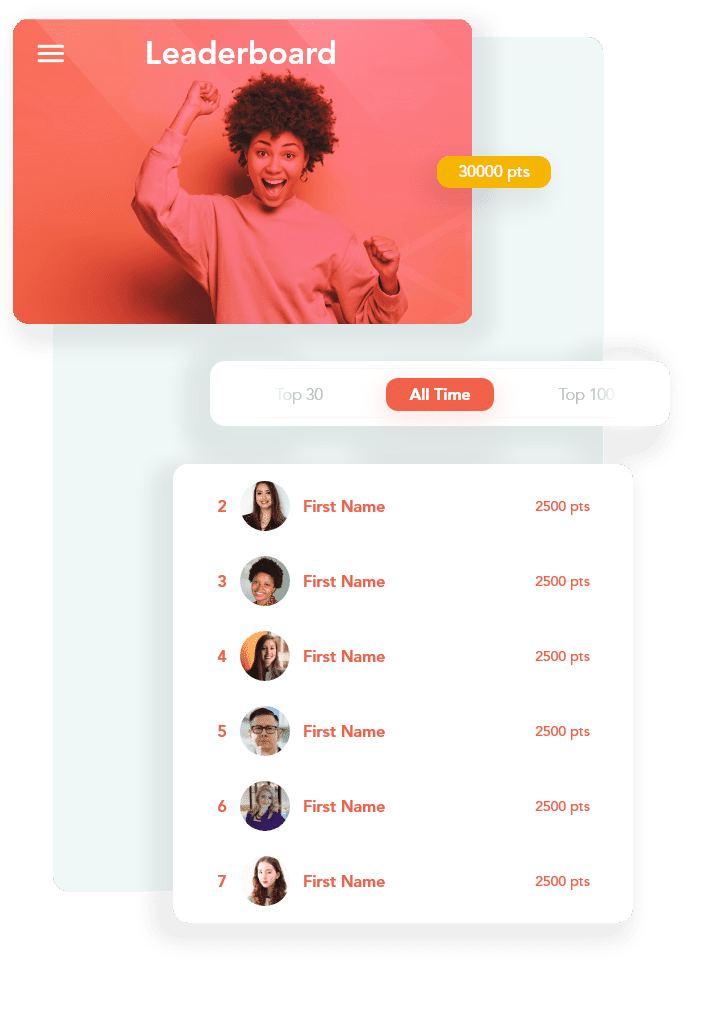
Surveys & Polls
Surveys and polls are a great way to get immediate feedback from your audience. Hosts can use polls during live presentations which can serve as an icebreaker for the networking events.
Hosts can also have polls after board meetings to quickly gather feedback. vFairs can easily integrate with Slido so you can include various polling options.
This feedback will give you a better idea of what concerns or challenges attendees face and will help you improve future events.
Social Media Walls
Social media event walls serve as an engagement tool that allows you to view valuable content posted by speakers and attendees using event’s hashtags. A social wall also provides attendees the ability to upload content directly on the wall.
The wall facilitates the interaction between attendees, sponsors, speakers, and administrators. You can display your curated content on a screen at the physical venue, and embed it into the event’s website to show it before or after the event.
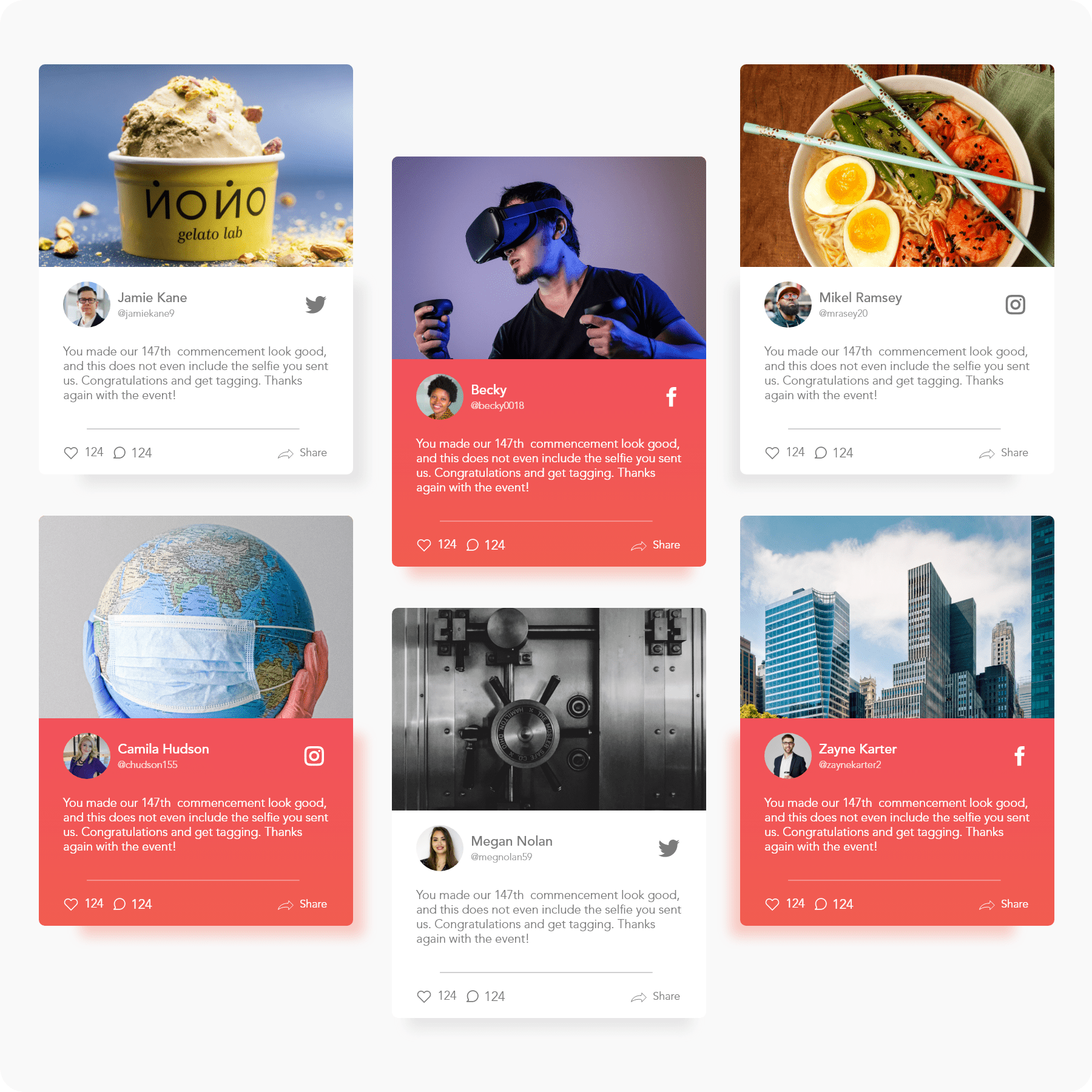
Moderated Q&As
Moderated Q&As can be used during webinars, within the exhibit booths. Attendees can submit questions and you can publish their answers within the chat function. Administrators, however, do have the ability to approve the questions if they deem them appropriate and beneficial to the rest of the audience.
Moderated Q&As can help you manage unwanted and irrelevant comments, create connections through meaningful conversations, and curate a list of FAQs for your booth visitors.
Downloadable Documents & Videos
Downloadable documents and videos give attendees the opportunity to reflect back at the event and relive it. They can go through them from time to time and refer to them as resources.
User Profile Search and Contact Sharing
With user profile search and contact sharing, attendees can effectively find people they’re interested to communicate with, or refer them to other people.
The search filter helps them filter people to match their interests, professions, educational background, and more.
Gamification and Contests
As mentioned earlier, contests can directly affect engagement of the attendees. Contests, games, and competitions engage exhibitors, attendees, and sponsors alike. The organizers can make them as interesting as they like and new ideas are welcome. Organizers can also host a contest between exhibitors to make it more fetching.
You can create contests based on other features, such as leaderboards and scavenger hunts.
Chapter 9: Advanced Hybrid Event Strategies
Touchpoint Mapping
Touchpoint mapping is where physical and virtual attendees can connect and share the same event experience, and network opportunities. These touchpoints are extremely important to make sure both the attendees have a similar experience.
After all, hybrid events are one event, but offer two experiences.
Some of the examples of touchpoint mapping include:
- Virtual venue that looks like the physical one
- Virtual exhibit booth that mirror the physical ones
- Chat and other networking features for both the attendees
- Live streaming and virtual presentations
- Discussion boards for both the attendees that get the conversation going
- Activity feed where both the attendees can share photos and videos
- Social walls where everyone can post photos of the virtual and on-site setup to compare
- Contact sharing through virtual platform and mobile app
Encouraging Virtual Participation from In-person Attendees
When catering to two diverse groups of attendees, it is vital to represent both in the physical space. Therefore, it is essential to align your on-site attendees with the virtual ones.
Hybrid events provide various concrete experiences to engage the on-site attendees. Examples include exhibitor booths, showcases, and face-to-face meetings. Since the virtual audience has a ton of disturbances to deal with, it is highly crucial to work on how to keep them engaged at their best.
You must ensure that the online attendees are well represented on-site through breakout rooms, chat rooms, and Q&A sessions.
However, a good way to encourage virtual participation to on-site attendees is to engage them in virtual activities that are fun, engaging, and informative. One example includes social media walls where both attendees can post and share valuable content. This would encourage networking through channels outside of the event as well.
Another opportunity is to ask the on-site attendees to fill in their user profiles and contact information on the mobile app that would help them network, and make connections with other attendees – virtual or in-person.
Repurposing Content
When planning hybrid events, it is essential to plan according to the two distinct types of attendees: in-person and virtual. The content should be relevant to both the attendees and should not have joint activities that would make one group feel isolated from participation. Therefore, it is important to keep both the attendees equally engaged.
Here are multiple ways to repurpose your content so that it resonates with both your audiences:
- Turn marketing collateral into brochures or infographics – it can be given out in the printed form physically and as a PDF in the virtual event.
- Presentations in the physical venue can be recorded and repurposed to on-demand videos or small snippets for social media.
- Turn event success stories into blogs and articles
- Re-host virtual conferences online with live streaming
- Sell your content through on-demand videos using a drip campaign
- Create a webinar learning series
Chapter 10: Hybrid Event Challenges
1. Planning One Event, not Two
When starting out, it can be a bit confusing to understand which aspects of the event to focus on. It’s difficult to decide how to bring together the in-person and online event. Unintentionally, your event planner might just put together two entirely separate events rather than one unified one. Managing the logistics, costs, and management is a challenge in such a situation. Keeping a steady balance between the two event formats such that they are synced is critical.
Here, it heavily depends on your virtual event platform of choice. Creating a unified experience means you must choose event technology that supports this goal, without draining you financially and experientially. Using various different platforms will lead to a haywired hybrid event, so stick to one virtual event platform which can seamlessly connect with your physical event plans.
Because this event type is so new, you might still have some differences, and some asymmetries here and there. That is inevitable when hosting hybrid events for the first time. With time these will be ironed out.
2. Outlining Your Ticketing Strategy
When virtual events gained steam at the start of the pandemic, organizers were struggling to set ticket prices. Caught between incentivizing people to attend and not losing money they had some tough decisions at hand. However, in-person events more often than not have a standard price or a ticket attached. So when it comes to a hybrid event, what will be your ticketing strategy?
You aim to create one event, however, the experience is different online and an in-person. Considerations such as venue costs – food and beverages, accessible content, sponsors etc. come into play. To tackle this conundrum, create ticketing tiers and levels. Various parts of the online and in-person events can be available to different people based on their ticket level. This allows flexibility to the attendees, and greater control where they are the decision-makers in what part of the event they actually want to pay for.
3. Creating Value for Exhibitors and Sponsors
Your exhibitors and sponsors want maximum visibility. They want to be seen, heard and want brand awareness. Sponsors and exhibitors have fared well in virtual events. But now the challenge is convincing them of the value they derive from hybrid events. In addition to awareness and visibility, exhibitors and sponsors get data and leads too with virtual events.
Three key factors determine an exhibitors and sponsors level of interest. Firstly, increased awareness as a global audience is at your disposal through the virtual aspect of your event. Secondly, sponsors can interact with attendees on the trade show floor in-person as well as through virtual profile search and meetings, hence more opportunities for lead generation. Thirdly, insights into attendee behavior as detailed event reporting features showcase how many attendees logged in to the event, the subsequent actions they took for instance the webinars attended, time spent in each webinar and more.

Combining together the virtual and physical aspects of the event seamlessly will provide even more insights into the event and its success thus helping organizers improve their future rendezvous.
As an organizer you must make both happy with on-site and online presence through booths, banners, graphics and more. Sponsors need opportunities in a hybrid event. By using the swag bag you can not only involve audiences, but increase exposure for sponsors as well. Sponsors can use this to send out merchandise and informative resources to their audiences. Where an actual swag bag is handed out to the in-person audience, a virtual swag bag can be sent to the online attendees. Where possible, online attendees can be sent swag bags too. This can instantly lift the experience for sponsors and attendees alike.
4. Harmonizing Online and Onsite Audiences
Getting people to interact in-person is easy with breakout sessions etc. Connecting people together online via networking lounges, interactive webinar sessions is also quite simple. But with hybrid events, the challenge is to keep the harmony between both audiences and create maximum opportunities for them to interact with each other.
As an organizer you can take a few steps to help them connect. Firstly, introduce people with similar industries or professions. Secondly, use social media to your advantage. Using a hashtag can help people see what others at the event are saying. You can also use integrations such as walls.io where you can display content from various social media content in a unified feed. Social media is an instant engagement driver, and such integrations further create opportunities for attendees to connect.
The end goal remains to empower attendees and facilitate seamless networking cross-platform, and this serves that goal.

5. Catering to different time zones
With an in-person event engaging people from various different time zones is always a challenge. This greatly reduced the reach. In came virtual events as a solution. Attendees could be in any time zone and could easily log in. However, with hybrid events this again presents a problem.
Taking into account remote audiences and setting a suitable time will be a challenge of hybrid events. To counter this, organizers can again coordinate with their event provider to either host over multiple days or create on-demand content so no one feels left out.
Key Takeaways
Here are the key takeaways from our hybrid events guide:
- Anyone can host a hybrid event. Hybrid events have various types such as conferences, job fairs, hybrid presentations, virtual trade shows, and more.
- It is of utmost importance to provide similar event experience to both the attendees.
- Hybrid events cost much less than the physical ones with a guaranteed higher ROI.
- The more focused the content, the better.
- Hybrid event marketing will work wonders for your event.
- It is important to cultivate shared event experiences with proper networking.
- You can increase event experience with engagement.
- vFairs can be your ultimate hybrid event platform.
Download The Ultimate Guide to Hybrid Events here.
FAQs
What is a hybrid event platform?
A hybrid event platform offers the opportunity to seamlessly blend the advantages of in-person and online event hosting for a truly exceptional experience. The primary objective of this platform is to unite both the on-site and virtual audience, granting them an equitable chance to engage with each other as if they were physically present in the same location.
Remote attendees can join using a virtual event software platform. In-person attendees can use a mobile app for better navigation and engagement. Moreover, event technology also plays a role in enhancing the attendee experience.
How much does a hybrid event cost?
An approximate cost of a hybrid event is $35,000, including physical venue cost at around $20,000 and virtual venue costs at approximately $15,000 but it depends on the event size.
What is the best hybrid event platform?
With many options to choose from, all hybrid event platforms have some unique features. However, vFairs is highly recommended.
Being one of the top rated solutions according to G2 reviews, vFairs has certainly made its mark in the events industry. We have been named the industry leader in G2 Reports, with an average rating of 4.7/5.
What are the top challenges of hybrid events?
One of the main challenges of hybrid events is to keep both the attendees, virtual and in-person, equally engaged and have them enjoy a similar experience.
What technology is needed for a hybrid meeting?
The first and the foremost technology that is essential to have is a virtual platform where the feed can be hosted live.
For production, high quality cameras, lighting, and microphones are essential. For live streaming, the production team directs a live feed through the control room or AV equipment.
What is the difference between hybrid events, and in-person events?
In-person events only focus on a physical event where the attendees have face-to-face sessions. However, hybrid events are a perfect blend of both in-person and virtual audiences. They cater to two distinct audiences in one event.
What is the difference between hybrid events, and virtual events?
Virtual events are those where everybody joins in virtually through a virtual event platform and there are no physical attendees. However, hybrid events are the best of both worlds and combine virtual audiences and on-site attendees in one event.

